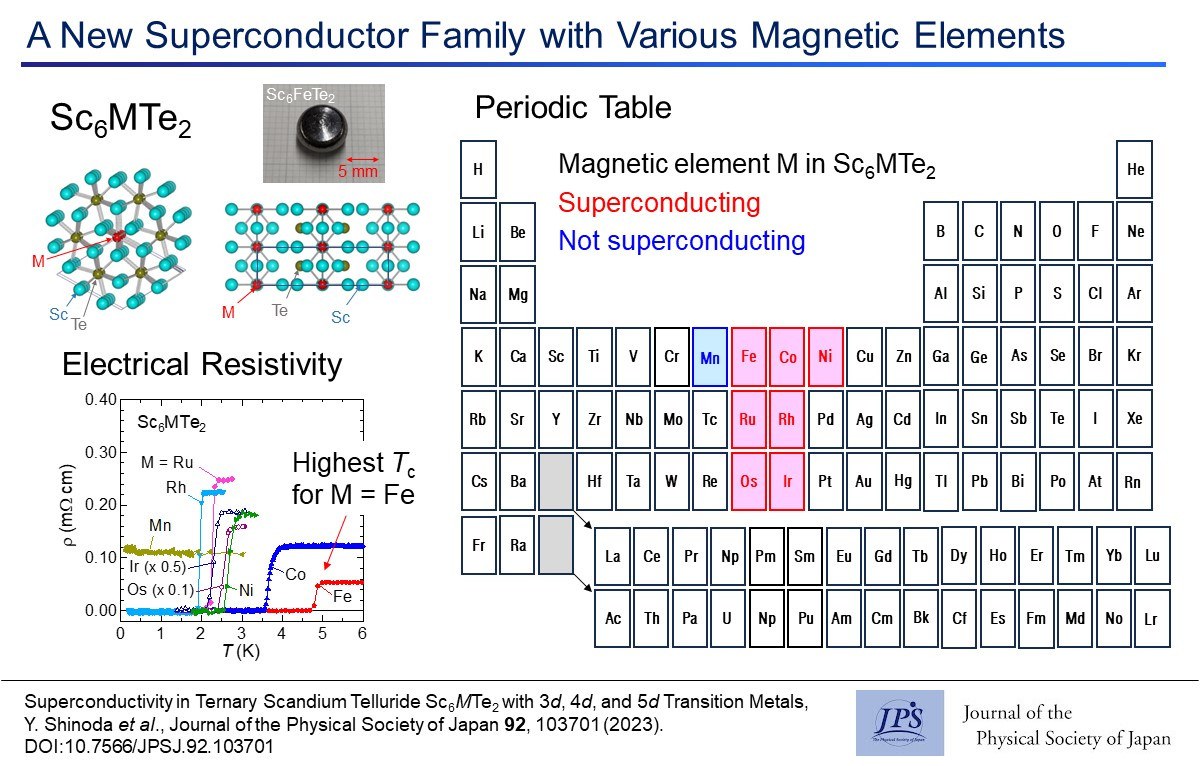A New Superconductor Family with Various Magnetic Elements
© The Physical Society of Japan
This article is on
Superconductivity in Ternary Scandium Telluride Sc6MTe2 with 3d, 4d, and 5d Transition Metalss
(JPSJ Editors' Choice)
J. Phys. Soc. Jpn.
92,
103701
(2023)
.
A new superconductor family, Sc6MTe2, has been discovered, comprising seven variations with magnetic elements labeled as M. Notably, only a few known superconductor families exist that involve various magnetic elements.

Understanding the connection between superconductivity, which is when a material loses all electrical resistance at low temperatures, and magnetism, a magnetic property of material, is significantly intricate. Normally, strong magnetism disrupts superconductivity; hence, materials with magnetic elements like iron tend not to exhibit superconductivity. However, materials containing magnetic elements rarely display unconventional superconductivity with remarkably high transition temperatures or unusual characteristics that defy existing theories. Unraveling the complex relationship between superconductivity and magnetism may be crucial for achieving superconductivity at room temperature. Discovering unique superconductors plays a key role in shedding light on this condition.
We investigated a family of materials, Sc6MTe2, consisting of scandium (Sc), tellurium (Te), and various magnetic elements like iron, cobalt, and nickel. These materials exhibit superconductivity in different cases, with specific superconducting transition temperatures varying depending on the magnetic element. For instance, Sc6FeTe2 boasts the highest transition temperature of Tc = 4.7 K. Families of superconductors containing diverse magnetic elements are quite rare. We anticipate that further research on this superconductor family will enhance our understanding of the interplay between superconductivity and magnetic elements.
Author: Yoshihiko Okamoto, representing all the authors.
Superconductivity in Ternary Scandium Telluride Sc6MTe2 with 3d, 4d, and 5d Transition Metalss
(JPSJ Editors' Choice)
J. Phys. Soc. Jpn.
92,
103701
(2023)
.
Share this topic
Fields
Related Articles
-
Qualitative Changes in Kinetic Pathways Driven by Hydrodynamic Interactions in Dense Colloidal Suspensions
Cross-disciplinary physics and related areas of science and technology
Statistical physics and thermodynamics
Structure and mechanical and thermal properties in condensed matter
2025-4-18
Even in dense colloidal suspensions, where long-range hydrodynamic interactions are screened, near-field hydrodynamic interactions qualitatively influence the selection of kinetic pathways.
-
Fractional Vortex Array with Nontrivial Topological Structure Realized at Twin Boundary of Nematic Superconductor
Superconductivity
2025-3-24
Analysis of the two-component Ginzburg-Landau theory suggests that a conventional vortex is transformed into two fractional vortices with the topological nature of core-down and core-up merons at the twin boundary of a nematic superconductor.
-
Exploring the Vibrant Interplay of Machine Learning and Physics
Cross-disciplinary physics and related areas of science and technology
Electron states in condensed matter
Elementary particles, fields, and strings
Mathematical methods, classical and quantum physics, relativity, gravitation, numerical simulation, computational modeling
Statistical physics and thermodynamics
Superconductivity
2025-3-13
This Journal of the Physical Society of Japan Special Topics edition explores how physics and machine learning complement each other and can solve unresolved problems in physics.
-
Excitonic Insulators: Challenges in Realizing a Theoretically Predicted State of Matter
Electron states in condensed matter
Electronic transport in condensed matter
2025-3-3
The realization of an excitonic insulator can help in the establishment of a new electronic state in condensed matter physics, one that has the potential to exhibit novel electric, magnetic, and optical responses beyond those of conventional materials.
-
Exploring Materials without Data Exposure: A Bayesian Optimizer using Secure Computation
Cross-disciplinary physics and related areas of science and technology
Measurement, instrumentation, and techniques
2025-2-6
Secure computation allows the manipulation of material data without exposing them, thereby offering an alternative to traditional open/closed data management. We recently reported the development of an application that performs Bayesian optimization using secure computation.




